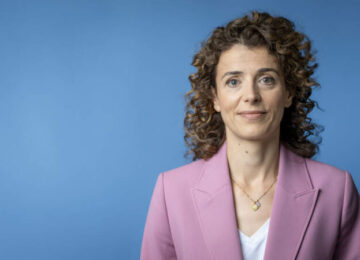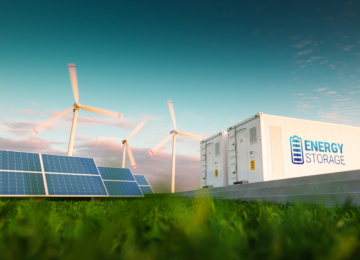"We have passed the tipping point" - Rens Savenije explains how we make large-scale batteries profitable
Batteries are all-rounders. They create flexibility on the power grid and energy market. They can help solve grid congestion and contribute to security of supply. Moreover, they make room for the growth of wind and solar power. And yet, making battery projects profitable is a challenge. Rens Savenije, business lead system integration, explains how Ventolines arrives at a positive business case.
System Integration
Rens Savenije started at Ventolines five years ago as business lead system integration. What exactly do we mean by that? Savenije: "System integration is about the question: what needs to be done to incorporate wind and solar energy? What does the energy system of the future look like?"
"System integration includes requiring industry to use electricity at the same time as wind and solar energy," Savenije says. "We are moving from a supply-driven energy system to a demand-driven system. Grid operators have to invest very hard in a stronger national and European power grid. And energy storage is also system integration, preferably integrated into a wind or solar farm."
Why batteries are now booming
In April this year, Rens Savenije was interviewed about the 'flood of applications' for batteries at the grid operator. This huge increase did not surprise Savenije: "Five years ago I started as business lead system integration at Ventolines. At that time there was very little attention to battery storage in the Netherlands. We were pioneering the first projects. Then the war in Ukraine broke out and power prices skyrocketed. The volatility in the markets was enormous. In that year, you could make an awful lot of money with energy storage. That woke up a lot of people."
Battery projects now underway at Ventolines
"By now we have passed the tipping point, and more and more customers are interested in investing in energy storage," Savenije says. Ventolines was involved in several of the Netherlands' first major battery projects. The very first was for Greenchoice ('Mega Battery at wind farm in Rotterdam harbor," AD, 2018). Savenije: "We don't think that one is big at all now. That was one of 10 megawatts. Now we are involved in projects up to 500 MW. At Westermeerdijk high-voltage substation in the Noordoostpolder, for example, batteries of 250 MW will be built. In these, 650,000 megawatt hours of electricity can be stored annually. That is comparable to the consumption of 200,000 households."
From development to contracting, construction and management
The projects now underway are largely in the development stage. This makes sense, as many of these projects were started at the time of the 2022 price hikes. Savenije: "For those initiatives we are now in discussions with competent authorities about the permits. There are also projects that we have already taken to the next stage: there is a grid connection and a land position, and in any case the prospect of a permit. So then a customer already has some certainty and we start the contracting; the procurement of all installations. In the meantime, we prepare for construction and management."
Transportation costs hold up business case
So there are quite a few battery projects in development and there are many investors. But they are still taking a high risk. There is no business case yet for a stand-alone battery. Rens Savenije explains why: "That has to do with the transport costs; the costs charged by the grid operator for drawing power from the grid. That tariff has increased fivefold in recent years at TenneT. Only the end user pays the costs for this.
The net squeaks and creaks
And what is so contradictory now, according to Savenije and many professionals with him: "Batteries are currently still seen as consumers. While in fact they are an indispensable link, helping to solve the problem of grid congestion and imbalance. TenneT says 9 gigawatts of controllable power is needed in the grid before 2030. Otherwise, the high standard of security of supply we are used to in the Netherlands will no longer be guaranteed. If we really want that, we need system batteries. The grid is already squeaking and creaking. That is why it is so important that something is done about this."
Netherlands lags behind
In other Western European countries, the implementation of battery projects is already much further along. Savenije: "Almost all the European countries around us have introduced an exemption on transport costs for batteries. As a result, you now see one large project after another being announced in Belgium, Germany and the United Kingdom. The Netherlands is really lagging behind in this."
Annual 2 billion damage from grid congestion
A recent study found that the damage of not implementing batteries in the grid far outweighs the revenue from transmission costs. This is mainly because we will increasingly have to deal with power failures, and these in turn cause defects in appliances. (Research firm Ecorys: 'Large batteries can make Dutch society Saving €2 billion a year.')
The grid is locked and that's holding back economic growth
Industry in particular is feeling the effects of grid congestion. Savenije: "The electrification of industry is super important for the energy transition. But the grid is locked up and that is holding back economic growth and sustainability. Industrial estates cannot now switch from gas to their own solar roof with heat pump because the grid is too heavily burdened. And that in turn works to keep businesses from locating and expanding."
Cost-effective business case for batteries
Yet Ventolines has developed a solution to make the business case for a battery profitable even now. Savenije: "We make a combination with, for example, a wind farm. We do not connect the batteries directly to the grid, but we install them as we call it behind the meter. The battery only charges directly from the wind farm. In the hours when it's not windy, you lose revenue with the battery because you can't charge. But you also avoid those very high transportation costs in those hours. There's a certain optimum somewhere in there."
Complex mathematical models
"We devise trading strategies where we size the battery so that the revenue you lose by not being able to charge is less than what you would pay in transportation costs. I've been working on this for five years. We use these complex mathematical models to advise our customers when considering a battery. This is how we arrive at a business case that can be made."
Cable pooling at business parks
We also assist industrial and business parks in sharing grid connections through a legal structure: 'virtual cable pooling. Savenije: "We help these customers conclude smart contracts with the grid operator. The companies on such an area can then make optimal joint use of solar, wind and batteries via an energy hub. We create what we call a virtual cable pool, in which we coordinate the use and generation of energy on the site. In this way, these parties can still expand and become more sustainable."
Cable pooling
At Ventolines we provide all services around renewable energy, from A to Z. That has a number of unique advantages, especially in system integration. Savenije: "We have a very strong legal department that has developed a model contract, for example, for cable pooling; the sharing of grid capacity for wind, solar and batteries. Something like that requires an awful lot of agreements, especially if different owners are involved." The model agreement ensures that we can quickly make all the legal agreements for our customers.
Model contract drives energy transition forward
Our lawyers developed the model contract in cooperation with Invest NL and the industry association. Savenije: "We have made that model contract publicly available. We really do that out of conviction, to accelerate the energy transition. Very many parties cannot afford such a contract, even though they need it."
Integrated approach gives clients bargaining power
Customers also benefit from our integrated approach in the permitting process, Savenije says. "What many customers run into is that you have to apply for a building permit for a battery. For that, you have to know exactly what the battery looks like; right down to the joint of the brickwork. That forces customers to choose one specific battery early on. We therefore write the permit so that the municipality has enough details, but our customers still have options. Otherwise you are stuck with one supplier and there is no room for negotiation."
"We would like to keep that option open ourselves," Savenije says. "We don't find it desirable to choose a supplier too early. We hook up people who normally are not yet in the picture at all in the permit phase. Specialists in construction, for example. In all phases we think about the final picture for the customer. You can only do that if you have all the services in house."
Energy Storage Event
Meet Rens Savenije at the Energy Storage Event on Dec. 7, 2023, at the Jaarbeurs in Utrecht. He is one of the speakers.





